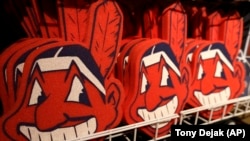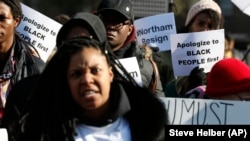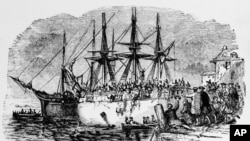Almost every week, John Little sees images of Native Americans being represented as relics of the past.
There is the picture of a young Native woman on a container of butter. There are the children’s teepees sold at popular stores. And, there are the sports fans. People who support teams with Native-American-connected names often paint their faces and do the “tomahawk chop.” The movement was meant to look like a Native American using a sharp tool called a tomahawk.
Little lives in the southwestern state of Arizona and is a member of the Standing Rock Sioux tribe. He notes that many Americans have been discussing a lot about racist imagery in recent months, especially about the history and meaning of blackface.
But such discussions have not included the outdated and often offensive representations of Native Americans.
"These are everyday realities for Native people," Little said.
Experts say that “redface” – the practice of dressing or acting like a Native American - gets less attention than blackface for a few reasons. European Americans have deep-rooted but mistaken ideas about American history. Also, Native Americans make up less than 2 percent of the United States population. African-Americans, by comparison, make up about 13 percent.
Native American have tried for years to make people understand that stereotyping Native Americans as violent, uninformed and humorless is deeply offensive.
They have not seen much change, however.
Throughout America's history, people have put on redface, worn feathers and spoken in broken English as they "played" Native Americans in theater, film and everyday life. In one of the earliest examples, colonists who were dressed as Mohawk Indians poured tea into the Boston Harbor in 1773 in protest of British rule.
Philip J. Deloria is a Harvard University history professor and writer of "Playing Indian." He said most people think that those old images, largely based on 19th-century Plains Indians, represent who Native Americans were and still are.
Some even believe Natives no longer exist in the country.
"There's a big, long, complicated history to this that's really deep in American culture," Deloria said. "It's every bit as deep as blackface minstrelsy and slavery. It's just out there, but we've kind of forgotten about it."
The most common place to see redface is at sporting events for teams like the Washington “Redskins,” the Atlanta “Braves” and the Cleveland “Indians.”
There have been protests against the “Redskins” name for 50 years. But the team’s name has not changed. But some news organizations have refused to publish the name of the football team in America’s capital.
In 2017, John Little made a documentary film about the team and its chosen name. It is called “More Than a Word.” In it, fans explain that they think the team name honors Native Americans. These fans paint their faces, perform their versions of a Native American dance or war cry and wear fake headdresses.
For many Native Americans, “redface” is not limited to actual face paint. It also includes clothing and speech. The sight of sports fans wearing feathered headdresses is especially insulting to many Native Americans. The headwear is historically a sign of great honor and respect, earned by tribal chiefs.
Kyle Mays is a professor of African American and American Indian studies at the University of California-Los Angeles. He is both black and a member of Saginaw Anishinaabe, a Native tribe. He said, “It’s hard for me to say people don’t know it’s wrong….They might not know Native people, but they know it’s wrong and it’s just OK to do because there are not any consequences for it.
Nicholet Deschine Parkhurst, who is Lakota and Navajo, has been criticizing the companies that use Native American culture in an offensive way. She wants them to show indigenous people in a more modern way.
"When you're viewed in that way, as only existing in the past, as the 'frozen Indian' found in museums ... it makes it harder for voices of leaders in our communities to actually be heard, and it's easier for people to ignore us," she said.
Although changes have been slow, there have been some positive signs. The Cleveland Indians sports team, for example, has new clothing for players that does not include the image of “Chief Wahoo” – a Native American face shown in bright red and wearing one feather.
And, the U.S. Lacrosse association said last month that it plans to remove offensive Native American mascots and signs from events that it puts together.
I’m John Reynolds.
And I’m Jill Robbins.
Jill Robbins adapted it for Learning English based on Associated Press news report. Ashley Thompson was the editor.
_______________________________________________________________
Words in This Story
relic - n. something that is from a past time, place, culture, etc. — often + of or from
teepee – n. a tent that is shaped like a cone and that was used in the past by some Native Americans as a house
stereotype – v. to believe unfairly that all people or things with a particular characteristic are the same
indigenous – adj. produced, living, or existing naturally in a particular region or environment
headdress – n. a decorative covering for your head
consequence – n. something that happens as a result of a particular action or set of conditions
fake - adj. not true or real
complicated – adj. hard to understand, explain, or deal with
minstrelsy – n. the practice of performing as a minstrel - a member of a group of entertainers who performed black American songs and jokes usually with blackened faces
mascot – n. a person, animal, or object used as a symbol to represent a group (such as a sports team) and to bring good luck
Does your culture use images of the native people of your country in popular culture? Are the images respectful or do they cause anger? We want to hear from you. Write to us in the Comments Section.












